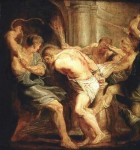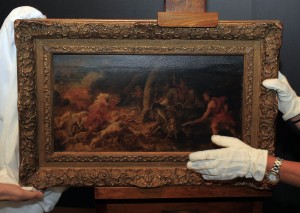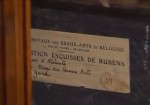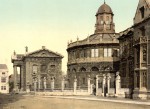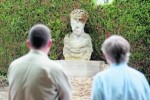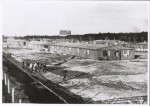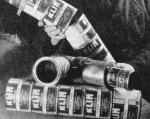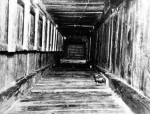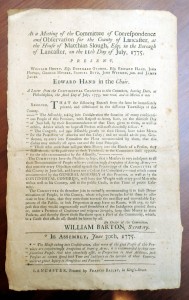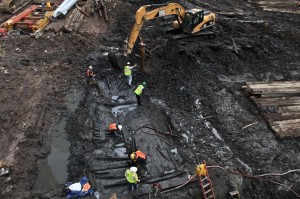 Last summer, construction workers on the World Trade Center site uncovered the remains of an 18th century shipwreck. Since then, researchers have identified the ship type as a single mast sloop around 50 feet long with a shallow draft (the section between the waterline and the bottom of the hull which determined the depth of water the ship could navigate without running aground) and rounded stem and stern both.
Last summer, construction workers on the World Trade Center site uncovered the remains of an 18th century shipwreck. Since then, researchers have identified the ship type as a single mast sloop around 50 feet long with a shallow draft (the section between the waterline and the bottom of the hull which determined the depth of water the ship could navigate without running aground) and rounded stem and stern both.
Scientists from Columbia University’s Tree Ring Lab have studied samples from the ship’s white oak planks and its hickory keel trying to match it to the known record of tree ring history from different parts of the country and world. Since an 18th century ship in New York City could have been built locally or have come from Europe, that makes for a great many possible matches to go through. The use of hickory for the keel narrowed down the search because unlike the white oak that makes up the planking, hickory has been extinct in Europe for two million years.
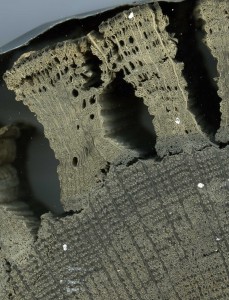 The team dried the timbers slowly, sanded the samples so the rings would be countable, then got counting. You need at least 100 years of rings to have a viable sample for comparison, which they were lucky enough to secure. They ran their samples through a database of tree ring chronologies from the Hudson Valley, then hit pay dirt when they compared to the chronologies from Philadelphia. One of the samples had come from a Philadelphia tree was at least 111 years old and still growing when it was felled in 1773. The sample had a thick outer section where rivers of sap had flowed through in its last year.
The team dried the timbers slowly, sanded the samples so the rings would be countable, then got counting. You need at least 100 years of rings to have a viable sample for comparison, which they were lucky enough to secure. They ran their samples through a database of tree ring chronologies from the Hudson Valley, then hit pay dirt when they compared to the chronologies from Philadelphia. One of the samples had come from a Philadelphia tree was at least 111 years old and still growing when it was felled in 1773. The sample had a thick outer section where rivers of sap had flowed through in its last year.
If the hull was part of the original vessel and not part of a refurbishment, the tree ring data point to a launch date for this shallow-sailing sloop that was sometime after the 1773 winter’s Tea Party in Boston, and likely before the signing of the Declaration of Independence on July 4, 1776, in the vessel’s hometown. This is a boat that sailed during the American Revolution with a crew that traded up and down the Hudson River goods, such as leather shoes, they had collected during several long bouts spent in the Caribbean. But the crew were a bit lousy (but, really, who wasn’t back then?) and, in its own way, so was the boat, having picked up tiny wood-boring Teredinidae mollusks, “the termites of the sea.” But as Kevin Eckelbarger of the University of Maine’s Darling Marine Center, who identified the shell morphology in the bored-out timbers, told Scientific American, “They are really aggressive. They make termites look like amateurs.”
The ship had other structural problems caused by a luxury fitting. The builder used iron fasteners to common the planks of the hull. Iron was far more expensive than wood, and, as it happens, far less efficient. It was both a luxury and a sloppy construction shortcut. It takes a lot less effort to put parts together with an iron fitting than to drill a hole through the inner and outer planks then jam an oak trunnel through it. Those wood trunnels expanded and contracted along with the planking, however, so even though they were a cheaper and more time-consuming material, they kept the ship together better than the iron that would tear, rust and friction-burn wooden hulls.
Historians speculate that the shipbuilder must have gotten his hands on a cheap source of iron, perhaps captured from the enemy during the Revolution, and decided to use them to put the ship together quickly.
As far as what the ship might have carried, what role it might have played in the American Revolution, there are tantalizing clues but nothing we can pin down. It was a mercantile sloop so could have just carried foodstuffs and consumer goods up and down the Atlantic, but it could also have been used in the war. Similar ships served on both sides, carrying ammunition, evacuating Royalist noncombatants during the war and British troops after, even attacking enemy vessels and ports.
One of the puzzle pieces into the history of the discovered World Trade Center vessel includes a pewter button with the number 52, a regiment of the British Army. Whether this is from a captured British soldier or something a superstitious sailor found remains unanswered. Perhaps the British were the last to claim the vessel. As Riess said, the British held New York City throughout the war, and evacuated in 1783 after the treaty in Paris. The last humans on the sailboat left it to sit on the shores of New York harbor where other occupants endemic to saltwater marshes such as horseshoe crabs, sponges, oysters, and snails made the oak planks home.
